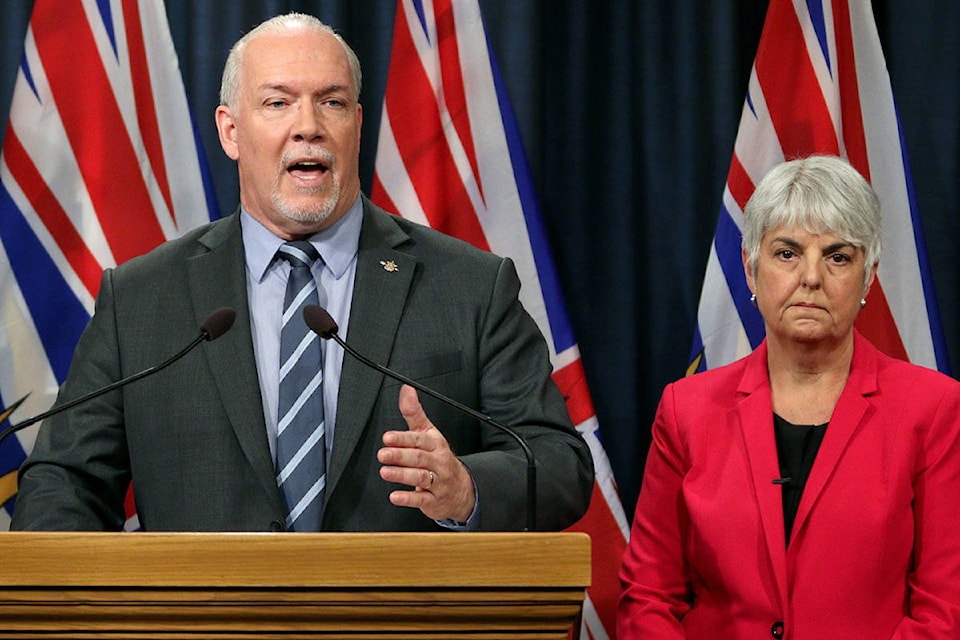The B.C. government is unveiling a host of measures meant to get the economy going, including a tax credit for employers who bring on more employees in the last few months of 2020.
The province’s economy has been hit hard by the COVID-19 pandemic, which shut down much of B.C. for several months this spring. Last week, Finance Minister Carole James said the province was projecting a $12.8 billion deficit for the fiscal year that ends in March 2021.
READ MORE: B.C. deficit forecast $12.8 billion after first three months of COVID-19
Although B.C.’s COVID-19 cases have been increasing in the past few weeks, with an average of more than 100 cases in recent days, the province is pushing ahead with economic recovery plans.
“COVID-19 changed not just our world, but the world,” Premier John Horgan said at a press briefing Thursday (Sept. 17).
“There is no playbook on how to handle a global pandemic.”
Between February and August, B.C. lost 33,900 jobs in wholesale and retail trade; 25,200 in information, culture and recreation; and 24,600 in construction, the only trades field to see a loss of jobs. However, not all industries lost jobs; utilities gained 6,700 thousand jobs; professional, scientific and technical services gained 5,500 jobs and agriculture gained 4,200 jobs.
Consumer spending saw a big dip in the spring of 2020, although monthly retail spending in June rebounded to $7.4 million, just $15,664 below pre-pandemic retail spending in February.
The economic recovery plan is valued at $1.5 billion, part of more than $8 billion in COVID-related funding this year. There is also an additional $660 million in tax breaks, including $190 million to encourage hiring by employers to lower B.C.’s 10.7 per cent unemployment rate, and a $470 million PST rebate on business investments such as machinery and equipment that promotes business expansion.
The province already announced the $1.5 billion for economic recovery earlier this year, but Thursday’s (Sept. 16) announcement broke it down into four categories: recovery for people, recovery for communities, recovery for businesses and building better futures.
And here is B.C.'s consumer spending. Big drops seen in clothing + gasoline, but increases everywhere else – especially electronics + appliances. Also note big dip in Spring 2020 spending that's all but recovered to Feb 2020 levels by June. @BlackPressMedia #bcpoli #COVID19 pic.twitter.com/WrCrJ6BPRm
— Kat Slepian (@katslepian) September 17, 2020
Recovery for people, which totals $469 million, includes $300 million set aside for up to 7,000 new jobs in health care, $20 million or supports for people with disabilities, $20 million for short-term skills training for in-demand jobs and $15 million for community skills training and education for Indigenous peoples. It also includes $45.6 million previously announced for school COVID-19 measures.
Recovery for businesses, which totals $405 million, is largely made up of $300 million in small and medium sized business recovery grant, which the province said will save 200,000 jobs. Another $50 million will be allocated to a tourism task force, which will determine where funds are most needed and allocate them before the end of the 2020/21 fiscal year.
Recovery for communities, which totals $375 million, has $100 million dedicated to a COVID-19 Community Economic Recovery Infrastructure Program, which will provide grants for “shovel ready” projects.
Finally, the building better futures segment of the funding, which totals $250 million, includes $25 million for food security programs such as expanding B.C.’s food production and processing and invasive species detection and removal. Another $223 million will go towards future-facing projects including $90 million to improve connectivity along major routes and in rural communities, as well as $35 million towards a Centre for Innovation and Clean Energy.
The last $7 million of the economic recovery plan is dedicated to capital costs, including construction in provincial parks and remote and rural road access, part of which will go to improving the road between Port Alberni and Bamfield on Vancouver Island.
Like us on Facebook and follow us on Twitter.
Want to support local journalism during the pandemic? Make a donation here.
